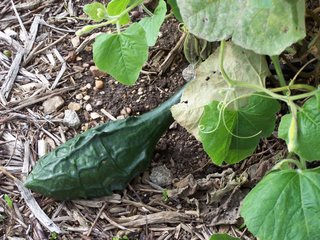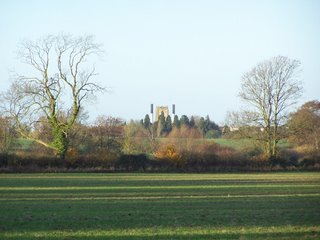Strange Fruit Dinosaur GourdDinosaur Gourd seems to be a variety of Bottle Gourd, Lagenaria siceraria, so is related to cucumbers, squashes and pumpkins. It seems better known in the US, where it is also known as Caveman’s Club, and seed merchants say it was traditionally used to decorate sweat lodges. It needs a long season to mature, but did well this year outside at Ryton’s Vegetable Inspirations garden.
Dinosaur GourdDinosaur Gourd seems to be a variety of Bottle Gourd, Lagenaria siceraria, so is related to cucumbers, squashes and pumpkins. It seems better known in the US, where it is also known as Caveman’s Club, and seed merchants say it was traditionally used to decorate sweat lodges. It needs a long season to mature, but did well this year outside at Ryton’s Vegetable Inspirations garden. LoofaLoofa (Luffa aegyptica) is also a Cucurbit. It will produce a bath-worthy fruit in this country, but needs a very long growing season undercover, such as in the rather nice Alitex greenhouse at Ryton. In optimum conditions a loofa can reach 4m long, approximately three times as long as the average bath. It can be eaten if picked young, unlike a bath sponge.
LoofaLoofa (Luffa aegyptica) is also a Cucurbit. It will produce a bath-worthy fruit in this country, but needs a very long growing season undercover, such as in the rather nice Alitex greenhouse at Ryton. In optimum conditions a loofa can reach 4m long, approximately three times as long as the average bath. It can be eaten if picked young, unlike a bath sponge. 
Hairy Balls
Hairy Balls, or Gomphocarpus physocarpus, is also known less chortle-worthily as Swan Plant and Balloon Cotton Bush. The US Thompson and Morgan Catalogue says it ‘adds fun to borders and cut flower arrangements’. So, “Come into the garden, Maud, and see my Hairy Balls”? It’s much less available in the UK.
It's native to South Africa, but has been introduced to the Pacific Islands and Australia, where its wind-dispersed seeds mean it is a problem weed. It is poisonous to animals (except goats) as well as humans, and is cultivated for medicine in China. (NB I googled the Latin name, not the colloquial…)
Credit to Lesley, a gardener at Ryton, who grew all these plants.







